Create your own Safari Extension

Did you know that anyone can build an extension for Safari? It is no problem, anyone can do it and it’s actually easier than you might think.
Read more »

Did you know that anyone can build an extension for Safari? It is no problem, anyone can do it and it’s actually easier than you might think.
Read more »
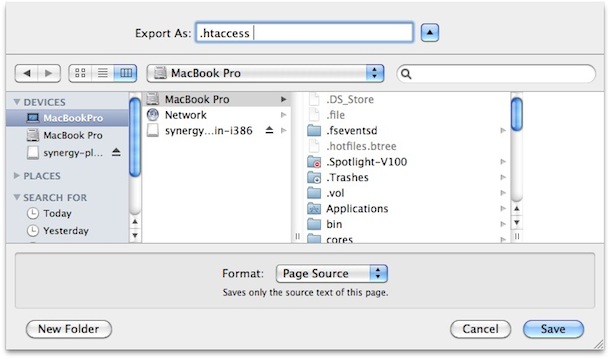
Did you know that you can quickly see or hide all the hidden files in a directory from any Mac Save window with a simple keystroke? This is very useful when you are saving a file to a directory that will appear as invisible, also known as a dotfile in OS X.
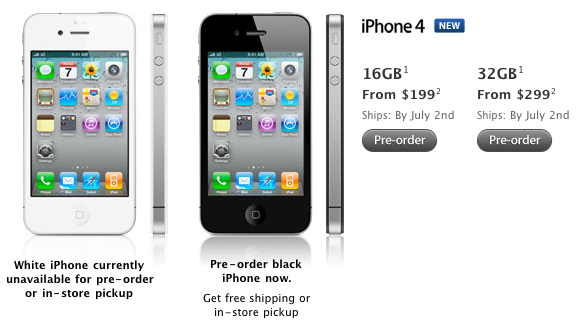
You probably already know that AT&T has sold out all of it’s pre-orders for release date iPhone 4 deliveries, and now Apple has too. You can still pre-order iPhone 4 but the ship date displays ‘by July 2nd’ ‘by July 14th’ on Apple’s online store, meaning your only chance of getting iPhone 4 on release date is waiting in the lines that are sure to come.
The demand for iPhone 4 is truly remarkable, customers trying to get their hands on the device caused both AT&T and Apple’s Online Store to crash yesterday, and long lines formed worldwide even just for placing pre-orders.
You can get more information about iPhone 4 including availability, stores carrying the device, prices for the phone and data plans, and possible AT&T upgrades at the links below:
iPhone 4 Availability
iPhone 4 Price Guide
iPhone Upgrade Eligibility
Your Mac runs a series of maintenance scripts on it’s own to clear out various cache and log files. To see when the scripts were last run, type the following at the command line:
ls -la /var/log/*.out
You will then see something like this:
-rw-r--r-- 1 root wheel 283124 16 Jun 02:15 /var/log/daily.out
-rw-r--r-- 1 root wheel 1143 1 Jun 05:37 /var/log/monthly.out
-rw-r--r-- 1 root wheel 2420 13 Jun 02:15 /var/log/weekly.out
If the scripts haven’t been run in a while and you feel like manually executing them, type the following:
sudo periodic daily weekly monthly
or you can specify just a single script to run:
sudo periodic weekly
Generally it’s unlikely you’ll need to run these scripts on your own.
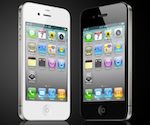 If you didn’t get your iPhone 4 pre-order in successfully today, it looks like you’ll have to wait a while for delivery. Reports circulating around the web indicate that AT&T iPhone 4 pre-orders have all sold out for anyone wanting to get the phone on release date. This isn’t too surprising considering the hype the device has received, iPhone 4 availability was expected to not meet the enormous demand.
If you didn’t get your iPhone 4 pre-order in successfully today, it looks like you’ll have to wait a while for delivery. Reports circulating around the web indicate that AT&T iPhone 4 pre-orders have all sold out for anyone wanting to get the phone on release date. This isn’t too surprising considering the hype the device has received, iPhone 4 availability was expected to not meet the enormous demand.
According to AT&T, the pre-order date for iPhone 4 was the busiest sales day in their history (as if the AT&T online store breaking wasn’t an already clear indicator of that):
“Because of the incredible interest in iPhone 4, today was the busiest online sales day in AT&T history. As of Tuesday afternoon, customers who preorder iPhone 4 moving forward will receive their device on June 25 or later, depending on when the order is placed. We’ll email customers with confirmation once their order is placed, and again when it ships. In addition, we will have devices available on a first-come, first-serve basis in our stores beginning on June 24.”
The above quote was provided by AT&T to Engadget and confirms the sell out. AT&T mentions that there will be devices available on a ‘first-come, first-serve basis’ on June 24, so expect some pretty serious lines for people hoping to nab one of the hot devices.
Fire up those Software Updates because Mac OS X 10.6.4 is ready for download. Addressing numerous bug and security fixes, it is a recommended download for all Mac users.

It looks like if you haven’t upgraded to Safari 5 yet, this software update handles that for you. The update comes in at a whopping 639.1 MB on my MacBook Pro 2010 model which makes for a pretty hefty download, but on another Mac right next to me the download is about 300MB, so the download size clearly varies from machine to machine and fixes that are relevant to the hardware.
Here’s what Apple says about the update:
The 10.6.4 Update is recommended for all users running Mac OS X Snow Leopard. It includes Safari 5 and general operating system fixes that enhance the stability, compatibility, and security of your Mac, including fixes that:
You can read more at Apple.com

Demand for iPhone 4 is huge, that’s expected, but would you have guessed that both AT&T and Apple’s order processing sites would collapse under the weight pre-order traffic? And would you have guessed that long lines formed to just pre-order the device? Both are happening right now.
Read more »

Apple released a new Mac Mini for 2010, the first update to the model this year. Getting a speed bump, HDMI output, and an SD card slot, the 2010 Mac Mini also looks different than it’s predecessors. Boasting a smaller aluminum unibody enclosure, the new Mac Mini matches closely to other aluminum products in Apple’s lineup. The tiny machine is being dubbed as “the world’s most energy efficient desktop computer” consuming a surprisingly small amount of energy, an amazing 10 watts when the machine is idle.
The new Mac Mini is smaller than ever, at just 1.4″ tall and 7.7″ wide and deep. Updated tech specs and features include:
Read more »
![]() You can easily stop the “Sent from my iPhone” text from appearing on your outbound iPhone emails, or change it to be something else. Removing or customizing the signature applies to emails that are sent as replies or as new messages from the iPhone, and you can set it to whatever you want, or to absolutely nothing, by modifying the iOS signature settings. It only takes a moment, and here is exactly how to do that on an iPhone or iPad.
You can easily stop the “Sent from my iPhone” text from appearing on your outbound iPhone emails, or change it to be something else. Removing or customizing the signature applies to emails that are sent as replies or as new messages from the iPhone, and you can set it to whatever you want, or to absolutely nothing, by modifying the iOS signature settings. It only takes a moment, and here is exactly how to do that on an iPhone or iPad.
This works the same in all versions of iOS.

Pre-orders for iPhone 4 start today at qualified iPhone sales locations!
Basically if you pre-order the iPhone you’ll be able to come back in two weeks on June 24th to the same store and pick up the device without waiting in the giant sales lines (in some cases the iPhone will be mailed to you).
The Apple Store will also ship the iPhone directly to your house.
If you’re having Synergy ‘cannot read configuration’ error problems, try the following:
* Get the latest version of Synergy KM from SourceForge
* Be sure the clients have the latest version of Synergy installed too (it’s pretty old for Windows clients, but works)
* Create a new ‘Location’ and re-add your server, screens, clients, in the order you desire.
* Pay attention to special characters and spaces, don’t use them in the synergy screen names. “ScreenName” is better than “Screen Name”
* Launch Synergy server and connect with clients
Now here’s the full explanation if you’re interested…
 I recently added an external display on my Mac and as a result I had to adjust Synergy’s server configuration to know where to place my Mac, the new external screen, and my PC. (For those that don’t know, Synergy is a great utility that allows you to share a single mouse and keyboard across multiple machines, regardless of their platform. Mac OS, Windows, and Linux are supported). This sounds simple enough, so I just added a new screen name for my new LCD in the Synergy control panel, and clicked “Apply” – unfortunately that didn’t work, I got several errors and Synergy wouldn’t start:
I recently added an external display on my Mac and as a result I had to adjust Synergy’s server configuration to know where to place my Mac, the new external screen, and my PC. (For those that don’t know, Synergy is a great utility that allows you to share a single mouse and keyboard across multiple machines, regardless of their platform. Mac OS, Windows, and Linux are supported). This sounds simple enough, so I just added a new screen name for my new LCD in the Synergy control panel, and clicked “Apply” – unfortunately that didn’t work, I got several errors and Synergy wouldn’t start:
ERROR: cannot read configuration "/var/tmp/synergy-A38198/
Was the first error, so I went and deleted the tmp files and tried again, to get a new error:
ERROR: cannot read configuration "/var/folders/iO/
I deleted those, and then got the first error again. Hmm, ok then. So what to do? I’ll just recreate the configuration, right?
I installed the newest Synergy KM, you can get the latest version of Synergy KM from SourceForge. I installed that and then entered into the “Server Configuration” tab in the Synergy KM panel. Created a “New Location” and added all my screens again, then started the synergy server. The server launched OK but was now throwing different configuration errors and wouldn’t let clients connect. Odd. So I re-added the screens again but just on a hunch I removed a space that I had in a screen name from “External Monitor” to “ExternalMonitor”, started the server again, and guess what? Everything worked. I thought this was really strange, but I’m guessing that for some reason the space in the screen name was causing Synergy to have difficulty in reading the configuration file. Dashes (-) seem to work fine, but spaces were problematic. I don’t have a ton of explanation for this because I’ve used spaces many times in names, but nonetheless that seemed to do the trick.
 After Apple released iOS 4 at an App Store centric WWDC 2010, many people questioned the future of the Mac. Well, MacsimumNews took it upon themselves to email Steve Jobs and ask about the future of the Mac directly, here’s the exchange:
After Apple released iOS 4 at an App Store centric WWDC 2010, many people questioned the future of the Mac. Well, MacsimumNews took it upon themselves to email Steve Jobs and ask about the future of the Mac directly, here’s the exchange:
Mr Jobs,
Newsweek just ran an “obituary” for the Mac, saying the Mac has been “relegated to the steaming dung heap of the past.”
I hope he’s wrong, I believe and hope that the Mac will remain a vibrant, vital part of Apple’s future and one of its (admittedly many) product lines.
So, as you view it, does the Mac have a long and important history ahead of it?
Dennis
Interestingly enough, Steve Jobs responded in his typical short and sweet manner:
Completely wrong. Just wait.
Here’s a screenshot of the exchange via the aptly named EmailsFromSteveJobs.com:
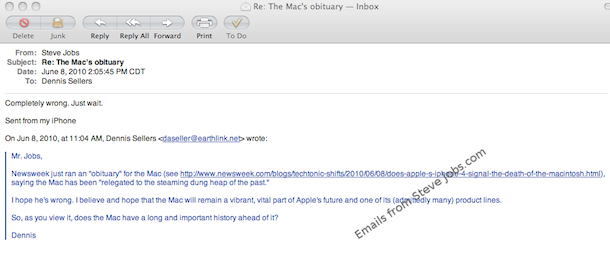
So does the response from Steve allay the fears of the Mac community? I’m going to go ahead with the assumption that the Mac will be around for a while, but who knows what the future holds? We just have to wait and see the actions (and inactions) of Apple.
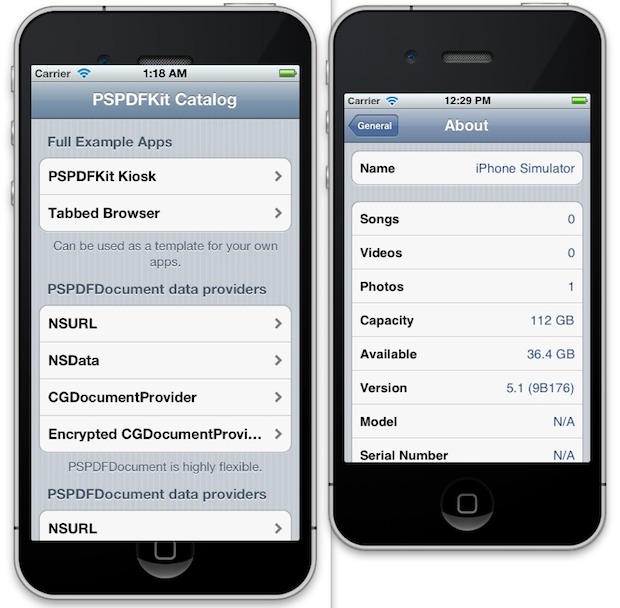
The iPhone Simulator, now called iOS Simulator, will emulate an iPhone or iPad. Newer versions of Xcode want you to launch the app through Xcode first, but that’s not entirely necessary. You can access the simulators directly through the Finder as well, here’s where to look for each version of Xcode:

Welcome to Shaqintosh. I don’t know the origin of this Shaq Mac image but it really cracks me up. Consider this your totally stupid post of the day.
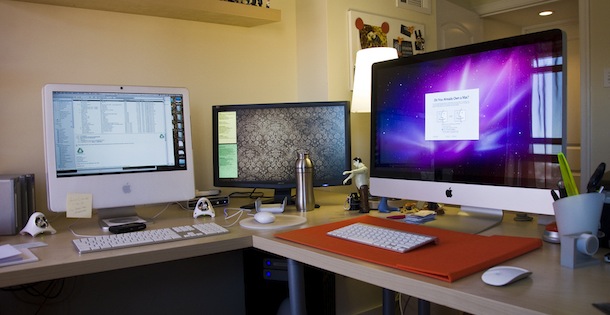
The 27″ iMac is a beautiful machine, this picture amuses me because it shows just how large the screen really is, dwarfing the older iMac and the 23″ Acer LCD next to it!
[ via Flickr ]
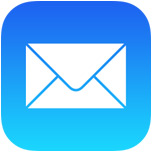 One of the Mac Mail apps many talents is the ability to automatically detect when a flight number is present in an email, and then give you the option to view the flights status by using the flight tracking Dashboard widget in OS X.
One of the Mac Mail apps many talents is the ability to automatically detect when a flight number is present in an email, and then give you the option to view the flights status by using the flight tracking Dashboard widget in OS X.
Yes seriously, the Mac eMail app can track flights! This doesn’t even require a plug-in, it’s all built into Mail for Mac, which passes the appropriate data onto the Flight Tracker tool to then gather more details and display the flight on a map.

iPhone 4 is here, it’s awesome, and everyone wants one. But what’s it going to set you back? What is the price of the phone and what’s the cost of the new AT&T data plans? How much is it to upgrade from an existing iPhone? Can you buy one without a contract? You know that iPhone 4 availability began on June 24, and now you’ll know how much it’s actually going to cost to get in your hands. This is the ultimate iPhone 4 pricing guide, read on.
The all new iPhone 4 is available in two colors, white and black, and each has two different storage capacity options that effect the price of the phone.
Keep in mind that in the USA, to get iPhone 4 at these prices you will have to renew or sign up for a 2 year contract with AT&T.
You’ll be able to buy iPhone 4 outside of an AT&T contract for an unsubsidized price, but it’s not cheap:
The reason for the high price is because the phone is no longer subsidized by the AT&T 2-year commitment. Suddenly that contract is looking appealing huh? But be sure to get the right data plan for your use.
If you’re a new AT&T customer you’ll have three data plans and pricing options to choose from:
It’s really important to know how much data you use, so if you’re an existing customer be sure to check your AT&T iPhone data usage before going into a new plan.
What about Unlimited Data? Unlimited Data is no longer offered, but if you are a current AT&T customer and you are still under an iPhone unlimited data contract, you can keep the unlimited data plan for $30/month as long as you do not let the contract or plan lapse. If you let it lapse or do not renew the unlimited data contract, you will not be able to get unlimited data again on AT&T. Again, once you lose unlimited data you will not get it again!

You’ll be able to upgrade to iPhone 4 if you already are in contract with an iPhone 3G or 3GS, but you’ll need to:
Note the $18 fee is waived for many people who’s contract expires anytime in 2010. You can check your AT&T iPhone upgrade eligibility to find out your contract eligibility and if the fee applies to you. The above applies to those iPhone 3G and 3GS subscribers who upgrade in 2010, after 2010 the price of the new iPhone goes up to $399 and $499, so if you’re thinking about upgrading you’ll want to do it in 2010.
According to MacRumors, AT&T will be offering both rebates and credits to recent purchasers of iPhone 3GS.
AT&T will be offering bill credit rebates for users who purchased an iPhone 3GS between May 7th and June 7th, with customers set to receive $50 (16 GB) or $100 (32 GB) if they file a request with the company. The offer is good for 30 days from the date of purchase, with those in the early portion of the purchase window (May 7th through May 14th) having until June 14th to file their requests.
The same story reports that AT&T may be offering iPhone 3GS users the option to upgrade to iPhone 4 if they pay the price difference between the phones:
iPhone 3GS customers who purchased handsets between May 7th and June 7th the option to upgrade to iPhone 4, only paying applicable price differences. Customers who purchased a “closeout” iPhone 3GS after June 7th are not eligible for these offers.
This information has not been confirmed and is based on some documents obtained by a third party. It’s entirely possible the rebates and credits won’t hold true.
The new iPhone is already selling like absolute hotcakes and is continuously sold out. Apple has done it again!
![]() As many loyal Safari users already know, the dedicated “refresh” button was removed from the browser’s toolbar starting with the release of Safari 4. It seems that Apple decided it would be better placed at the end of the location bar. The “new” format also includes a much smaller button which quite frankly is much harder to get to and easier to miss.
As many loyal Safari users already know, the dedicated “refresh” button was removed from the browser’s toolbar starting with the release of Safari 4. It seems that Apple decided it would be better placed at the end of the location bar. The “new” format also includes a much smaller button which quite frankly is much harder to get to and easier to miss.
Now that Safari 5 has the ability to use Extensions, you can bring back the classic look and feel by enabling the the “Safari Reload Button” Extension.